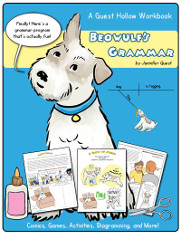Beowulf’s Grammar is a year-long grammar course written expressly for homeschoolers in grades two through six. It is presented in a student worktext (over 400 pages in length) and a teacher’s manual, both available only as downloadable PDF files. Note that Beowulf's Grammar is used as part of Guest Hollow's Language Arts Curriculum, a complete course covering grammar plus other areas of language arts.
Beowulf’s Grammar covers all eight parts of speech, punctuation, parts of a sentence, and usage. It also teaches both sentence analysis and diagramming to expose students to different approaches for understanding the functions of words in sentences.
Author Jennifer Guest’s goal is to make grammar more enjoyable for children to learn. For Beowulf’s Grammar, she has created a family that is featured throughout the book: siblings Abigail, Henry, and Grace plus the family dog, Beowulf. Lessons incorporate sentences and stories involving the family, all within the context of normal family life. The content is much more relatable for homeschooling families than the typical content of grammar books designed for classroom use. In addition, cartoons, colorful illustrations, fun graphics, cut-and-paste activities, games, puzzles, drawing activities, and occasional silliness make the course more appealing than traditional grammar courses.
Some traditional-style worksheets are used as well, and students will complete some copywork, but there are variety and creativity even with those pages. In addition to the approaches I have already listed, The Tale of Benjamin Bunny, along with some of its original illustrations, is used sporadically in the course as material for students to identify parts of speech within short excerpts from the story. As you can see, the course uses many different avenues to teach grammar.
Lessons are presented in fourteen units, each focused on a particular topic or group of topics. For example, the first five units are about nouns, pronouns, adjectives, verbs, and adverbs, respectively. However, these units also address other related topics. For example, possessives and apostrophes are included in the adjective unit, and subject-verb agreement is covered in the unit on verbs.
The sixth unit shifts to the parts of a sentence and an introduction to diagramming. Prepositions and prepositional phrases are taught in the next two units. After that, interjections and conjunctions are covered together in a unit that also teaches about phrases and clauses. Unit 10 teaches about direct and indirect objects. Unit 11 tackles predicate adjectives, predicate nominatives, and object complements. Prepositional phrases are covered in the twelfth unit, while punctuation and run-on sentences are covered in the thirteenth. Unit 14 wraps up with infinitives, gerunds, passive and active voice, and verb tenses.
Each unit concludes with a review. Optional review pages are in an appendix in the student book. These can be used up to three days per week for review and reinforcement, but since they are not required, use them as best suits your situation.
Older students might be able to work through Beowulf’s Grammar independently, while younger students will need some assistance. With older students, you might skip some cut-and-paste activities as well as activities that cover topics they have already mastered.
The teacher’s manual has images of student pages with overprinted answers, occasional teaching tips, and additional activities. A suggested schedule for 33 weeks shows lessons taught four days per week and review sheets used three days per week. You might choose to take more time to complete the course with younger students and less with older students.
The optional additional activities in the teacher’s manual that I mentioned might include composition, games, narration, dictation, copywork, research, field trips, or hands-on activities. For example, one activity says, “Look up the Gingerbread Man story. Have your student narrate it” (Beowulf’s Grammar Teacher’s Manual, p. 33). There are sometimes printable pages for these activities. As Guest explains, “Some of the extra ideas take concepts off the pages of a book and throw them into ‘real life.'” Sometimes this is the best way to learn!”
Homeschooling families are given permission to reproduce the student book for family members only. Co-op or group classes need to check on licensing fees.
While Beowulf’s Grammar can be used on its own, Jennifer Guest has also created an entire language arts curriculum with Beowulf’s Grammar as the spine. That curriculum covers spelling, vocabulary, composition, grammar, poetry, and some reading skills using a mixture of children’s literature and other fun learning resources. Both Beowulf’s Grammar and the language arts curriculum are secular programs.
Beowulf’s Grammar does a fairly good job of stretching to cover a broad range of grade levels, but those on the extreme ends of the scale will likely find parts of it too challenging or too easy, as you would expect. Third and fourth graders seem like the perfect audience. Nevertheless, homeschoolers can teach children from the broader span of grade levels together if they wish and can also have confidence that they are providing solid coverage for grammar.









